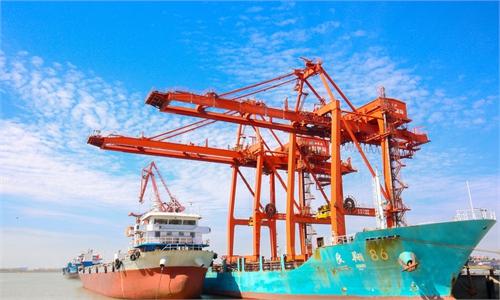Trade with US up 45.7% in H1, highest rate among China's major partners
Figure shows complementary nature of bilateral economic relationship: experts

China-US trade
China's trade with the US in the first half of 2021 was outstanding, as growth rate in US dollar terms was the highest among the nation's major trade partners - even if relations between the world's two largest economies remained frayed.Bilateral trade grew 45.7 percent year-on-year to $340.8 billion in the first six months of 2021, faster than China's trade with ASEAN (up 38.2 percent) or the EU (up 37 percent), statistics from the General Administration of Customs (GAC) showed on Tuesday.
The better-than-expected results proved the complementarity of the bilateral trade has become more prominent amid a natural disaster caused by Covid-19, experts said, predicting that the growth of China's imports from the US will continue to rise.
China's exports to the US surged 42.6 percent in dollar terms with Americans' appetite for laptops, smartphones, home appliances and clothes remaining robust, according to Chinese customs. Imports from the US jumped 55.5 percent in dollar terms.
The active trade relationship is partly reflected by busy cargo transport.
The volume of air cargo between Asia and the US is showing the fastest growth globally, while routes between Asia and non-US and non-European regions, as well as routes linking Europe and North America, saw no big changes, Kuo Zhang, vice president of Alibaba Group and general manager of Alibaba.com, told the Global Times.
The situation has led to an air cargo capacity gap between Asia and the US, Zhang noted.
"After the US introduced massive stimulus, Americans' consumption power rose although the country's economic recovery remained unbalanced. So it is hard for the US to find substitutes for Chinese goods in the short run," Sang Baichuan, director of the Institute of International Business at the University of International Business and Economics, told the Global Times on Tuesday.
Another expert who follows China-US trade agreed. "Based on the performance in the first half of the year, the complementarity of China-US trade has become more prominent," Gao Lingyun, a trade expert at the Chinese Academy of Social Sciences in Beijing, told the Global Times on Tuesday.
He noted that the results were achieved despite the coronavirus pandemic and tariffs imposed on some key foreign trade goods, which further proves that "it is useless to reduce a trade deficit by imposing tariffs."
China's trade surplus with the US increased to $32.58 billion in June, up from the May figure of $31.78 billion, according to the Global Times' calculations based on customs data.
Craig Allen, president of the US-China Business Council, in June published an article in Politico titled "US-China trade dispute harms Americans." He cited Moody's Analytics and said that American companies had shouldered more than 90 percent of the costs of US tariffs imposed on Chinese goods.
Given the US' domestic political rivalry, experts said that the situation of "political cold, economic heat" with China will continue. Recently, the Biden administration put more Chinese companies on the US Entity List, citing baseless claims of "forced labor."
"It contradicts the principle of win-win cooperation between China and the US," Gao said, urging the US government to create more favorable conditions for its exports to China.
In addition to robust trade with the US, China recorded 62.7-percent trade growth with India in the first half and 35-percent growth with Australia, both in dollar terms.
It is notable that China's iron ore imports, one of the major items of China-Australia trade, fell for a third straight month in June. China bought 89.42 million tons of iron ore from different countries in the month, down from 89.79 million tons in May, according to the GAC.
Exports to countries and regions along the route of the Belt and Road Initiative and RCEP trade partners surged 27.5 percent and 22.7 percent, respectively, in the first half of the year.


